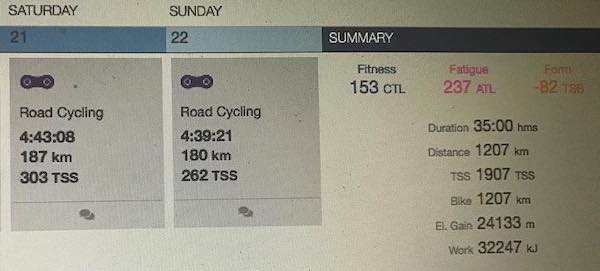
So, a bit of perspective. Above is a screenshot posted by Pierre Rolland, riding the real Tour de France for EF-Drapac. It’s his totals for the second week of the Tour, so will be an interesting comparison to my last week doing the Third de France.
|
Pierre |
Me |
| Hours | 35:00 | 13:03 |
| Distance | 1,207km | 351km |
| TSS | 1,907 | 768 |
| Work | 32,247kJ | 8,236kJ |
| Fitness | 153 | 55 |
| Fatigue | 237 | 13:03 |
| Form | -82 | -30 |
What’s interesting is the relationship between TSS (Training Stress Score) and Work. Pierre did 1907 TSS for the week, or 2.5 times my TSS. However, he did 32,247kJ of work, or 3.9 times the work I did. Work is a measurement, in kilojoules, of exactly how much physical work you have put into the pedals, whereas TSS is an approximation of the amount of stress that work has placed on your body. So despite Pierre doing almost 4 times the work that I did, it only stressed his body 2.4 times as much as my work stressed me.
The reason for this is that TSS is based on your FTP (your threshold, measured in watts), so that Pierre riding 1 hour at his threshold will generate the same TSS as me riding one hour at my threshold. However, Pierre’s threshold is probably 50% higher than mine, so he will do 50% more work at his threshold. He’s also at least 20kg lighter than me, so along with being able to do 50% more work than me at threshold, that work is moving a system (body + bike etc.) >20kg lighter, so he’s even faster again.
The other notable figure above is his Fitness score of 153. Fitness is measured in TSS per day and is the average amount of work he’s done over the previous three months and therefore also the amount of work he can now do per day without getting tired. At 153 TSS/day he’s three times fitter than me, though as we’ve seen above, TSS is based on threshold etc. etc. so he’s actually way better than that.
